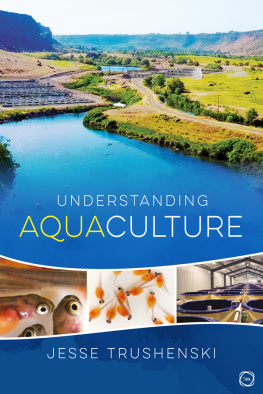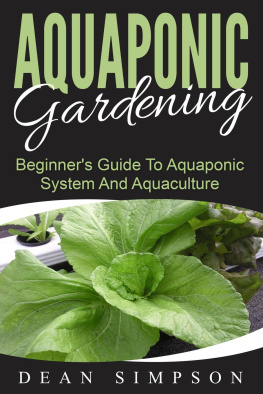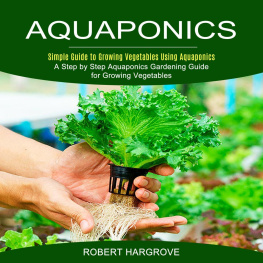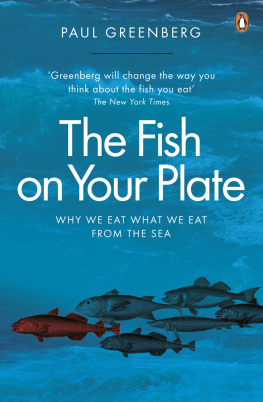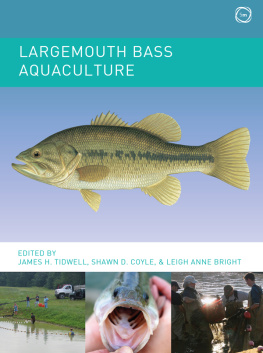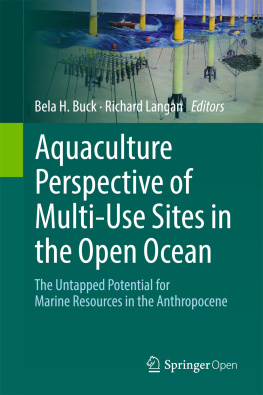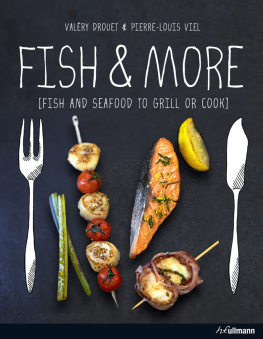Chapter 1
What is aquaculture?
D o you enjoy fishing? Do you enjoy seafood? Do you like the idea of your children and your childrens children being able to enjoy the same? If so, read on. This book is about aquaculture. It is about what aquaculture can and does provide the human race. It is about what aquaculture does well and where mistakes have been made. It is about informing the public mindset and, with new understanding, embracing aquaculture as a critical element of the future we would like to share with one another. It is, I hope, about understanding aquaculture, fully and appreciatively. First, we must understand aquaculture in the simplest terms its definition and basic forms.
Aquaculture takes its name in the manner of agriculture, replacing ager (Latin for field) with aqua (water) and combining it with cultura (growing, cultivation) to efficiently describe a multitude of practices (Oxford University Press, 2016). A number of related terms have been invented to try to define the rearing of plants or animals in either fresh or saltwater more narrowly. However, the inherent definition of aquaculture literally water cultivation applies to all of these endeavors and describes them with a simple elegance the other terms lack. There is a reason the title of this book is Understanding Aquaculture and not, for instance, Understanding Mariculture, Hydroponics, Ocean Ranching, and Fish Farming . Water is cultivated for a number of reasons, including food production, fisheries restoration, or for ornamental or other purposes. Modern aquaculture is so diverse that it defies even the most basic of categorizations. What is cultured? Throughout the world, hundreds of species of finfish (think salmon, catfish, trout, and so forth), crustaceans (shrimp and crabs), reptiles and amphibians (alligators and frogs), and mollusks (oysters and mussels) are raised. Why are they cultured? Fish and their aquatic brethren are raised as food, for natural resource management purposes, as pets, as experimental models for biomedical research, and so on. How are they cultured? Fish and shellfish are raised in ponds, tanks, cages or net pens, on floating rafts, and in other systems. Farms and hatcheries are located in open water, land-locked locales, and everything in between.
Perhaps because of aquacultures many forms, the public discourse includes a great deal of mis- and disinformation about what aqua-culture is and is not. Is farmed seafood safe to eat? Is wild fish more nutritious than farmed fish? Do hatcheries help or hurt wild fisheries? Dont fish farms pollute the environment? The media breathlessly delivers negative reports on aquaculture but, facts notwithstanding, rarely reports the benefits and importance of farm- and hatchery-reared fish and shellfish. Aquaculture has been practiced for many millennia, yet remains the most misunderstood means of producing food and other goods for human consumption. Roughly one-half of the seafood we eat comes from farms, and yet many consumers remain hesitant, even resistant to buying farmed fish. Aquaculture is compared with both terrestrial agriculture and capture fisheries and has endured considerable, often unfounded, criticism. Whereas terrestrial agriculture is considered a pillar of civilization, the unin-formed often dismiss aquaculture as an inferior alternative to fishing. More than ever, consumers want to know where and how their food is produced, and like any agricultural sector, the aquaculture industry has worked to address legitimate questions regarding environmental sustainability, animal welfare, and the sociopolitical dynamics of food security. But with so much conflicting information, it is sometimes difficult to know what is true and what is just a fish story. That is why this book exists and, if my guess is correct, why you have picked it up. Understanding Aquaculture will address the common questions and numerous myths surrounding aquaculture and separate fact from fiction. Aquaculture has tremendous promise, but an informed and supportive public is needed to ensure its potential is fully realized. The first part of this book will help familiarize you with aquaculture and how it is practiced throughout the world, and articulate some of the reasons why aquaculture is controversial. The following parts will dive deeper, addressing issues related to the health and safety of farmed fish and shellfish, environmental impacts, and the socioeconomic implications of aquaculture in detail. The concluding part will summarize these subjects and offer thoughts as to why and how we must think about and advocate for sustainable aquaculture.
The precise origins of aquaculture are unknown, likely having been discovered by more than one civilization. However, most historians believe aquaculture has been practiced in China for at least several thousand years. Chinese aquaculture began with cultivation of common carp perhaps as early as 20001000 BCE (Rabanal, 1988), the mid to late Bronze Age ().

Common carp, the first and most widely cultured fish in the world.
Source : Image from U.S. Fish and Wildlife Service National Image Library, created by Duane Raver.
By this time, a number of terrestrial animals had already been domesticated, including sheep and goats, cattle, pigs, llamas and alpacas, horses, cats, and, of course, dogs. For context, the first attempts at common carp aquaculture in China likely predated the invention of wheels with spokes, iron-based metals, and the phonetic alphabet. The oldest known monograph describing the cultivation of fish, The Classic of Fish Culture was written by the sometime around 475 BCE, meaning that aquaculture had undoubtedly been practiced by Lai, his contemporaries, and their ancestors long before the 5th century BCE.
In Asia and other parts of the world, our long-dead ancestors likely began capturing young fish and fattening them for the table much in the same way that terrestrial livestock were first domesticated. As detailed in the treatise, History of Aquaculture (Rabanal, 1988), four scenarios form the basis for how we presume aquaculture arose many millennia ago. According to each of the four complementary theories, observant and enterprising humans began cultivating the water largely for reasons of expediency. The first scenario involves so-called oxbows, the U-shaped lakes that form from the outward-curving bends of rivers as time and erosion work to disconnect them from the main channel. Flood events can rejoin oxbow lakes to their mother rivers, allowing fish and other organisms to move between them. When the waters recede, the corridors of connectivity close and the oxbow is once again separated from the river. For fish stranded in the oxbow, this may be a catastrophe or a stroke of good luck: if the lake dries out completely, all is lost; if not, stranded fish may find refuge from large predators and other dangers of the river, growing large and prolifically. Humans living near the river would almost certainly have known of these rich fisheries and might have begun to artificially recreate the ideal conditions by modifying the embankments of existing oxbows and supplementing the standing stock through periodic introductions of fish.
The second scenario involves seasonal lakes that form in the low-lying areas of tropical regions as flood waters recede following the end of the rainy monsoon season. These lakes could have been similarly improved and supplemented by human communities inhabiting nearby areas. The third scenario extends this concept to coastal regions, where ancient people fishing in pools and coves at low tide may have sought to increase their take by installing traps to keep temporarily stranded fish and shellfish from exiting during the next high tide. In the fourth scenario, humans may have begun cultivating the water to take advantage of the long-standing premium on fresh seafood. Rather than go fishing in inclement weather or at a moments notice, servant or peasant classes may have responded to the demands of nobility by holding wild-caught fish in communal water bodies constructed to provide drinking water or defense. Some of the stocked fish would avoid recapture and survive to reproduce and their progeny would be joined by additional fish transferred from natural waters. Each of the theories posits that a population of aquatic organisms is either created or commandeered, and managed first inadvertently, then through intentional manipulation to provide greater yields of seafood.

